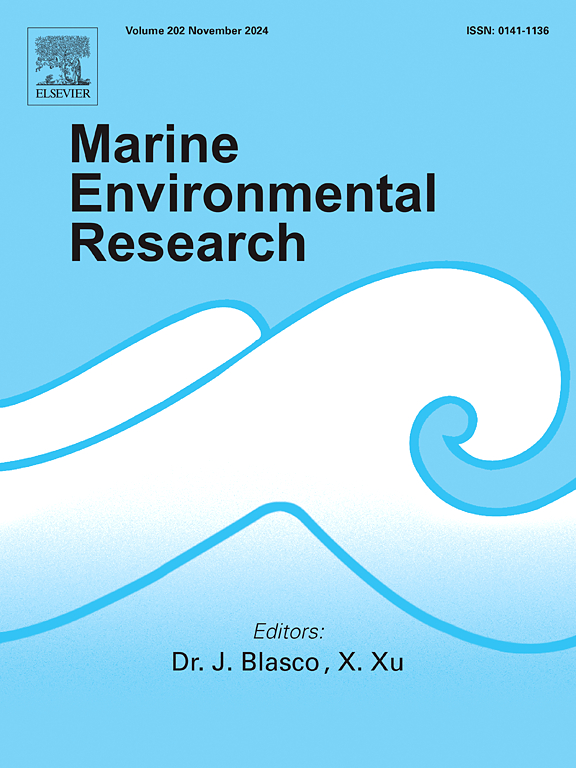入侵的狮子鱼在西南大西洋海洋保护区蔓延
IF 3
3区 环境科学与生态学
Q2 ENVIRONMENTAL SCIENCES
引用次数: 0
摘要
入侵狮子鱼被认为是海洋保护区(MPAs)的主要管理问题,因为它们的高密度和对当地生物多样性、渔业和食物网过程的不利影响。尽管存在这些紧迫的问题,但缺乏对西南大西洋海洋保护区狮子鱼当前和未来入侵的研究。为了解决这一知识缺口并支持全球海洋保护工作,我们的研究系统地评估了西南大西洋狮子鱼(Pterois volitans)入侵海洋保护区的范围和类型。此外,我们使用物种分布模型(最大熵模型)来预测该入侵物种未来的潜在分布。我们的研究结果显示,在2020年至2024年期间,狮子鱼已经成功入侵了至少18个海洋保护区(MPAs),横跨大西洋西南部4000公里的区域。其中包括12个可持续利用的保护区、3个海洋公园、1个生物保护区和2个专门保护手工渔业的保护区。根据已确认的入侵情况,大多数受影响的海洋保护区(78%)是多用途的,22%被指定为禁渔区。狮子鱼的数量预计将继续增长,部分原因是大多数(88%)海洋保护区缺乏定期的扑杀措施。潜在分布模型预测,狮子鱼目前出现在巴西33%的海洋保护区,并将在未来10年内将其范围扩大到另外25个海洋保护区,可能达到巴西海洋保护区总数的60%。结果还表明,在当前和预测情景下,底栖生物的盐度范围和海水温度是预测西南大西洋海洋保护区狮子鱼分布的最关键因素。狮子鱼的迅速蔓延凸显了采取协调管理策略的迫切需要,以减轻整个大西洋盆地狮子鱼构成的威胁。本文章由计算机程序翻译,如有差异,请以英文原文为准。

Invasive lionfish spread through southwestern atlantic marine protected areas
Invasive lionfish are recognized as a major management concern in Marine Protected Areas (MPAs) because of their high density and adverse effects on native biodiversity, fisheries, and food web processes. Despite these pressing concerns, there is a lack of research focused on the current and future invasion of lionfish in Southwestern Atlantic MPAs. To address this knowledge gap and support global marine conservation efforts, our study systematically assessed the extent and types of MPAs invaded by lionfish (Pterois volitans) in the SW Atlantic. Additionally, we used Species Distribution Models (Maximum Entropy modeling) to predict potential future distributions of this invasive species. Our findings revealed that lionfish have successfully invaded at least 18 Marine Protected Areas (MPAs) between 2020 and 2024, across a 4000 km stretch of the SW Atlantic. These include twelve protected areas with sustainable use, three marine parks, one biological reserve, and two reserves dedicated to protecting artisanal fisheries. Based on the confirmed invasions, the majority of the affected MPAs (78 %) were multiple-use, with 22 % designated as no-take areas. The growth of lionfish populations is expected to continue in part due to the absence of regular culling efforts in most (88 %) of these MPAs. The potential distribution model predicts that lionfish currently occur in 33 % of Brazilian MPAs and will expand its range to an additional 25 MPAs within the next 10 years, potentially reaching 60 % of the total Brazilian MPAs. The results also showed that the benthic salinity range and sea body temperature were the most critical factors in predicting lionfish distribution across SW Atlantic MPAs in both current and projected scenarios. This rapid spread underscores the urgent need for coordinated management strategies to mitigate the threat posed by lionfish throughout the Atlantic Ocean basin.
求助全文
通过发布文献求助,成功后即可免费获取论文全文。
去求助
来源期刊

Marine environmental research
环境科学-毒理学
CiteScore
5.90
自引率
3.00%
发文量
217
审稿时长
46 days
期刊介绍:
Marine Environmental Research publishes original research papers on chemical, physical, and biological interactions in the oceans and coastal waters. The journal serves as a forum for new information on biology, chemistry, and toxicology and syntheses that advance understanding of marine environmental processes.
Submission of multidisciplinary studies is encouraged. Studies that utilize experimental approaches to clarify the roles of anthropogenic and natural causes of changes in marine ecosystems are especially welcome, as are those studies that represent new developments of a theoretical or conceptual aspect of marine science. All papers published in this journal are reviewed by qualified peers prior to acceptance and publication. Examples of topics considered to be appropriate for the journal include, but are not limited to, the following:
– The extent, persistence, and consequences of change and the recovery from such change in natural marine systems
– The biochemical, physiological, and ecological consequences of contaminants to marine organisms and ecosystems
– The biogeochemistry of naturally occurring and anthropogenic substances
– Models that describe and predict the above processes
– Monitoring studies, to the extent that their results provide new information on functional processes
– Methodological papers describing improved quantitative techniques for the marine sciences.
 求助内容:
求助内容: 应助结果提醒方式:
应助结果提醒方式:


